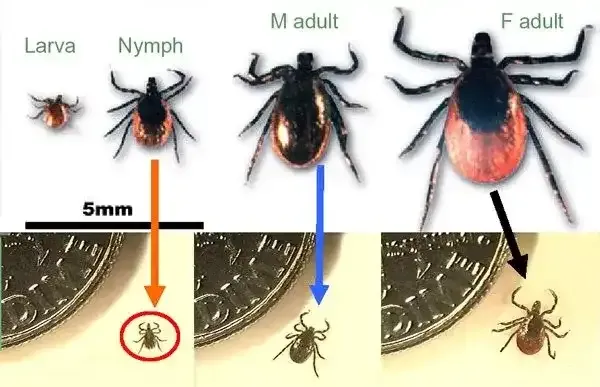Ticks and Parasitic Infection in Dogs:
A Washington, D.C. Primer
It is predicted to be another very active year for fleas and ticks, with increased prevalence and risks. The Mid-Atlantic region, including Washington DC, is known to have some of the highest tick activity in the entire nation. As the first DC dog hiking company, we know these pesky parasites thrive in warm weather conditions, making the Spring, Summer, and early Fall months especially risky. However, it is essential to remain vigilant throughout the year, as ticks have been spotted as late as November and as early as January.
Fleas and ticks, although pervasive, can be found in various environments, including urban areas and even dog day care facilities. Nevertheless, they are most commonly encountered in densely wooded areas and high-grass zones (i.e. dogs' favorite areas to explore!)

To protect our furry friends from the harmful effects of fleas and ticks, it is essential to implement a comprehensive preventive plan. Regular check-ups, grooming sessions, and the use of effective tick and flea control products are all part of the equation. By staying proactive and informed, we can ensure our pets' well-being and help them enjoy their outdoor adventures without any unnecessary risks.All Pant & Wag dogs are required to be on effective flea and tick medication, however it is still HIGHLY recommended you check your dog for fleas and ticks daily. The prescribed medications, while usually effective, sometimes don’t kill the parasites immediately, giving them time to transmit disease to your dog.
New Anti-tick Medications
In addition to the standard-bearers Frontline and K9-Advantix II, there are several new anti-tick medications on the market. Parastar Plus and Certifect promise a faster and more consistent ‘tick-kill’ and might be worth considering if you are concerned about ticks while your dog is on his hike. Ask your vet if these new medications would be the right choice for your dog.
A Note about Frontline: Frontline is the most popular flea and tick preventive sold. It is important to note that while a single dose is effective against fleas for up to three months, that same dose is effective against ticks for only 28 days. Even missing the dose by a few days puts your dog at risk. It is therefore important to apply Frontline every 28 days (not 30 days) to maintain protection against ticks.
Checking for Ticks
After each hike you should brush your fingers through your dog’s fur applying enough pressure to feel any small bumps. Be sure to check between your dog’s toes, behind ears, under armpits and around the tail and head, too. If you do feel a bump, pull the fur apart to see what’s there. A tick that has embedded itself in your dog will vary in size, something from the size of a pinhead to a grape depending on how long it’s been attached. Ticks are usually black or dark brown in color with a hint of red, but will turn a grayish-white after feeding in what’s referred to as an ‘engorged state.’
Removing Ticks
Removing embedded ticks is a delicate operation because it’s easy for a piece of the tick to break off and remain in your dog’s skin if done improperly. Follow the removal steps below or consider bringing your dog to a veterinarian who can safely perform the task and, possibly, show you how it’s done. Infection can occur after 24 hours, so if you find a tick on your dog, remove it right away. Always wear rubber gloves to protect yourself from possible injury or infection.
Grasp the tick as close as possible to the dogs skin with a pair of fine-tipped tweezers. With a steady motion, pull the tick’s body away from the skin. Avoid crushing the tick to prevent infection. After removal, clean your dog’s skin with soap and warm water and dispose of the tick by placing it in alcohol or flushing it down the toilet.
Following these steps can help ensure the successful removal of ticks. Never use petroleum jelly, a hot match, nail polish or other products to remove a tick. Doing so can harm your dog and may cause an embedded tick to release more disease-carrying saliva.
Testing for Disease
It is possible for your dog to get a tick, for the tick to infect your dog with a disease, for the tick to die as a result of the medication, and you wouldn’t even know any of this happened. The infections such as Lyme Disease, Rocky Mountain Spotted Fever, Anaplasmosis, and Ehrlichiosis are often asymptomatic in the early stages, but are also progressive and harder to remedy the longer they go untreated. That is why it is important to ask your veterinarian for a parasitic disease screen at every visit.



